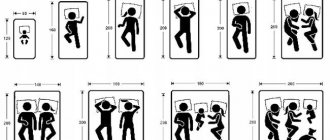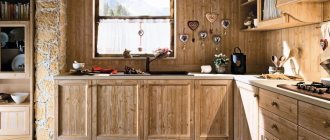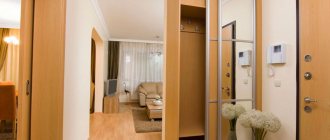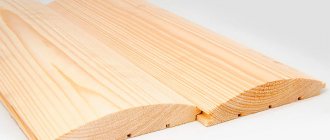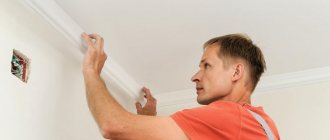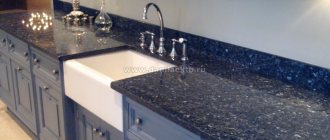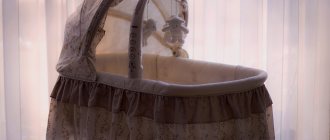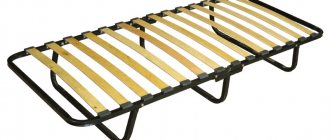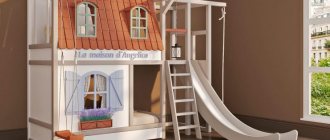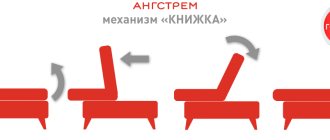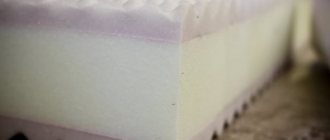What should a “one and a half” be like?
The one-and-a-half-size blanket is in great demand among buyers. This is an ideal option for those who prefer to sleep alone.
Below is a list of the most popular sizes:
- 140x205 cm. This blanket has been known since Soviet times and is perfect for small beds.
- 155x215 cm. This size came to us from the West and is already closely competing with other sizes. Another common name is “euro-one and a half”.
- 160x205 cm. Less common among buyers. Mainly purchased for children.
- 160x220 cm. This product is rarely bought, but these sizes are quite suitable for children.
A one-and-a-half-size blanket is often purchased for older children. This is explained by the fact that under such a blanket the child will sleep comfortably and freely.
How to choose a crib according to the age of the children?
A blanket in a crib should provide the baby with maximum comfort during daytime and nighttime sleep. An incorrectly selected blanket can cause anxiety for a child. The internal size of a standard crib for a newborn is 120x60 cm, so when choosing a blanket, experts recommend focusing on these characteristics.
If the child often turns over in his sleep, then it is better to choose a blanket slightly larger than the width of the bed. This reserve allows you to tuck it under the mattress and eliminate the possibility that the baby may involuntarily open up in his sleep, and the mother will not worry that the child will freeze. For restless children who sleep poorly and often wake up, experts often recommend making a cozy cocoon out of a blanket, tucking it in on three sides. This may require larger bedding.
Table of recommended blanket sizes, depending on the age of the child and the sleeping place used.
| Child's age | Bed size, cm | Featured blanket dimensions, cm | |
| Newborn crib | 0-3 years | 120x60 | 90x120, 100x118, 100x120, 100x135, 100x140, 100x150 110x125, 110x140 110x140 |
| Children's bed | 3-5 years | 160x70 160x80 160x90 | 160x100 160x120 |
| Teenage bed | 5 years and older | 200x80 200x90 200x110 | 140x200, 150x200 |
These recommendations are approximate, based on average data. Age limits may vary slightly depending on the height and weight of the child. As can be seen from the table, the size of a bed for a child over 5 years old corresponds to the size of a regular single bed. Accordingly, starting from about this age, you can consider the option of a regular one-and-a-half blanket for a child.
Weighted blanket: what is it and why is it needed?
At the very beginning of the article, we already mentioned that the central nervous system responds to a certain pressure on the body by releasing serotonin, after which a more active production of melatonin begins. As a result, the person relaxes and sleeps more soundly. This property is used in weighted blankets, that is, blankets with extra weight.
Research shows that weighted blankets help reduce anxiety[] and stress levels and help with insomnia[]. Pediatricians recommend these blankets for children with attention deficit hyperactivity disorder (ADHD) and autism spectrum disorder (ASD). Even though studies have not shown that a special blanket can improve the sleep of such children, scientists still recognized that children themselves prefer weighted blankets to regular blankets.
Different models of weighted blankets weigh from 2 kg to 13 kg. They use natural materials, such as buckwheat, or small plastic beads. You need to select the weight of the blanket based on the weight of the person who will sleep under it. For example, the creators of the Gravity blanket, popular in the USA, explain that the weight of the blanket should be 10% of a person’s weight.
What else do you need for a good sleep:
Large size blankets
Since blankets are widely used as bedspreads, as a warm cape on a cold autumn evening, as a rug on the floor for children's games, and the like, it is advisable to purchase large-sized products. These include bedspreads with dimensions: 180x200, 200x200, 200x300, 220x240 and 240x260, 280x300 cm. Such products are suitable for both large corner sofas and double beds.
The shape of large size blankets can be rectangular or square, as well as with rounded edges. Their main advantages include:
- good thermal conductivity. They pleasantly warm you up in the cool season and give pleasant emotions;
- long service life;
- ease of care;
- aesthetic appearance;
- wide model range.
When choosing, you should take into account its design, color, length and width, and sewing materials. All large size blankets are divided into warm and light ones.
If the product will be placed on the sofa, it should be easy to care for and durable. If you purchase it for the purpose of keeping you warm on cold winter evenings, it is advisable to choose natural warm fabrics.
Classification of blankets by size
At the beginning of the 2000s, GOST was established in Russia, which regulated the standardization of sizes. The dimensions of blankets for married couples were taken as a basis.
In accordance with the new rules, according to size, products were divided into several types:
- single or one-and-a-half-bed;
- double;
- double euro;
- family - euro maxi;
- children's
Such a variety of models allows you to purchase a convenient option for sleeping and relaxing.
Materials
Almost all characteristics of the product depend on the material used for manufacturing - comfort, thermal conductivity, hypoallergenicity, ease or difficulty of care, and much more. The fabric from which the product is made is selected taking into account the individual preferences of the future owner.
Blankets are made from such fillings as:
- Wool;
- Cotton;
- Cotton wool;
- Pooh;
- Bamboo;
- Silk;
- Synthetic materials.
Natural
Blankets made of wool are considered the warmest; as a rule, sheep or camel fur is used to make them. Depending on the thickness, they can be either winter or demi-season. Products made from merino (specially processed sheep wool) are becoming especially popular. They provide their owners with a sleeping place with high-quality thermoregulation and air ventilation.
Cotton is rightfully considered one of the most hypoallergenic materials of plant origin. But its disadvantage is that it does not retain heat well; it is better to use cotton blankets in the summer.
Blankets made of cotton wool in general are the same as cotton products, but due to the characteristics of the material they are very difficult to care for and quickly lose their advantages compared to other blankets. In addition, products made from cotton wool are notable for their considerable weight.
Duvets contain feathers or down of waterfowl such as ducks, loons and geese; these products are considered the warmest, softest and most breathable, and also have affordable prices.
Bamboo products have many advantages, the main ones being environmental friendliness, lack of allergic reactions and high hygroscopicity. They retain heat well and are suitable for use at any time of the year.
Silk products are predominantly summer models; the natural material has a high level of wear resistance and a long service life. Silk blankets have one drawback - their high price.
Perhaps the “Achilles heel” of natural fillers of any type is a favorable environment for the development of parasites and various harmful bacteria. That is why experts recommend purchasing natural products with special impregnation that protects the filler from the formation of a pathogenic environment.
Synthetic
Blankets made from synthetic materials have characteristics no worse than products made from natural fillings. Synthetics are distinguished by high quality, ease of care and affordable prices.
The most familiar and most common synthetic filler to consumers is synthetic padding polyester. Synthetic winterizer products are lightweight, durable and do not cause allergic reactions; such products can be washed without fear of deformation or pilling of the filler.
Holofiber takes pride of place among synthetic fillers. This type of material is reliable, light weight and has good thermal conductivity. In addition, holofiber blankets can be safely machine washed at home.
A high-quality prototype of natural down is Thinsulate; this material is very similar in characteristics to feathers, but the main difference and advantage is absolute protection from parasites, and as a result, hypoallergenicity.
The next no less popular analogue of natural material is lyocell. This prototype of cotton fillers is quite easy to use and maintain, is relatively inexpensive and has a high level of heat regulation.
Popular manufacturers of double blankets
When purchasing products, you should focus on quality and choose trusted brands. Unscrupulous manufacturers make cheap items from materials that do not meet standards and can absorb moisture and not allow air to pass through. As a result, the person will feel uncomfortable sleeping.
The best manufacturers of 2-bed blankets:
- Togas is a Greek company that has been producing textiles since the beginning of the twentieth century. Elite models are made of high quality materials. The company produces lightweight, all-season and warm blankets. The range includes wool, down, silk, bamboo and linen bedding.
- Ecotex is a domestic manufacturer operating on the market for more than 17 years. The company produces products from natural fabrics with different fillings: down feather, wool, bamboo, cotton, eucalyptus and polyester. The products are of high quality and affordable prices.
- TM Natures - a Russian company offers products for every season and taste. The cover fabric is cotton with antibacterial treatment. All products are made from environmentally friendly fillers and materials. Excellent appearance, optimal price and hygienic safety are the main advantages of the product.
- German grass is an Austrian brand of luxury bedding. All of them are made of expensive exclusive fabrics. The product undergoes strict quality control and meets international standards. Products are produced in three categories: light, warm and for all seasons.
- Cleo is the largest domestic manufacturer of home textiles, which has been operating on the market for more than 10 years. A large selection of models made from natural fabrics and low prices ensure constant demand for products.
- Ol-Tex - the company offers a wide range of bedding accessories. Russian products are distinguished by: original style, variety of fillers and affordable cost. A large selection of colors and materials can satisfy the most demanding buyer.
- Kariguz has been present in the textile market for more than 25 years. The choice of models is huge. The company produces bedspreads according to the degree of thermal comfort from summer to very warm winter, using natural and synthetic materials.
- Primavelle is a domestic company that offers a large selection of hypoallergenic bedding. The covers are made of natural fabrics: cotton, tencel, biosoft, and the fillings are made of artificial components: bamboo or ecofiber. The products can be washed in a machine.
- Dargez is a leading Russian manufacturer whose products are distinguished by a wide selection of fabrics and original design solutions. Consumers value products for quality, comfort and the ability to choose models of any color scheme.
- Lezheboka is a company that uses only natural modern materials for production. Raw materials undergo rigorous testing. We offer a wide range of European quality products. Price category - from economy class to elite.
Before entering the market, the products of these companies undergo thorough laboratory testing. Products are tested for strength, safety, hygroscopicity and the presence of harmful substances. All models are certified.
Classification of blankets by degree of warmth
The degree of warmth is the warming quality of the product. On product packaging this indicator is displayed in numbers or dots, the number of which varies from 1 to 5. Not every manufacturer follows this rule. However, knowing the classification of products, you can easily choose the right option.
Types of degrees of heat:
- Five points. Very warm models - made of wool and down, capable of keeping you warm at low temperatures. Especially suitable for those people who like to sleep with an open window.
- Four. Warm - designed for European winters with temperatures up to -10 degrees and colder climates.
- Three. Normal or all-season is a common middle type between summer and winter options. Suitable for moderate temperatures in the off-season.
- Two. Lightweight - suitable for cool periods when heating is turned on or for warm spring.
- One. Light - for hot weather. The main function is to retain body heat while sleeping on a cool summer night. The item must “breathe”, that is, ensure good air circulation.
When choosing a product based on the degree of warmth, you need to compare products based on the amount of filler. For those who prefer insulated items, a blanket with a lot of wool or down is suitable. Allergy sufferers should opt for synthetic products.
How to choose a duvet cover?
When buying a duvet cover, you must remember that the fabric from which it is made must be natural (linen, calico, cotton, satin, silk). The size should correspond to the size of the blanket, not small and not large. In the first case, it gathers in lumps, in the second, it slides into one of the corners. It is ideal to purchase a blanket that is 10 cm wider and longer than the size so that it fits freely. This applies to thick down ones. For lightweight and thin products, the margin can be 5 cm.
In addition, natural fabric shrinks after the first washes. Manufacturers take this factor into account and make a small allowance during production. For a traditional single-double product, a duvet cover with dimensions of 150x215 is suitable. The most common size on sale is 160x220. It is designed for blankets with a width of 150-155 cm, as well as for Euro one and a half quilts.
The duvet cover is purchased separately, as part of the bed linen set, and is sewn to order in the studio.
Translation of foreign size markings
European and American manufacturers have almost the same designations. Blanket size chart:
| Name: USA/Europe | USA, WxD, cm | Europe, WxD, cm |
| Twin/Single | 150Х201 | 145Х200 |
| Full/Double | 201Х201 | 200Х200 |
| Queen/King | 224Х218 | 230Х220 |
| California King/Super King | 259Х218 | 260/220 |
| Baby bed/Crid | 101Х121 | 100Х120 |
The table displays the average parameters. In France, for example, the smallest for an adult is 130X180 cm, and in Portugal 130X190, in the UK it starts from 180X230 cm - this is actually the size of a double blanket.
Types and standards
The dimensions of the bedding, as well as the set of elements, primarily depend on the purpose, or more precisely, on the bed on which it will be used.
Single
Suitable for beds up to 1 m. Includes one pillowcase (50*70 or 70*70), fitted or standard sheet (110-120*200), duvet cover ~135*200.
Recently, narrow beds have become less popular, so finding such textiles on sale is not easy.
One and a half
The size of the bedding set “1.5” is designed for a bed up to 140 cm, but is also suitable for narrower single beds. Unlike the previous one, there are no longer three, but four components: a sheet 150-160 by 200-220, a duvet cover 140-160 by 200, 2 pillowcases (50-70 by 70).
Most often, sets are made for children's and teenage rooms.
Double and Euro
The set is designed for a bed on which two people sleep: therefore, the duvet covers are wide (~180*210), the sheets are selected according to the mattress - standard: 200x220, but can be 240x260.
What distinguishes euro from regular double linen is the number of pillowcases: euros have 4 (2 squares, 2 rectangles), doubles - 2.
Moreover, Russian manufacturers prefer square shapes, European, Chinese – rectangular.
Family
The main difference between the family set is 2 duvet covers. They are not as wide as in Euro (~150*210), suitable for medium blankets.
Euro-maxi
This bedding set in Euro sizes is a curiosity. Not found often, it is suitable for people who prefer real comfort and wide king-sized beds.
Sheets and duvet covers are impressive: 220*240 cm (mattress covers are 240*260).
Important! When choosing a large bed, remember - it will not be easy to find something to cover it with, and non-standard textiles are expensive - sometimes twice as expensive as usual
Standard parameters
As always, first about the numbers in general. The table below contains product options, starting with blanket sizes 1.5, single-and-a-half and ending with the Euro-maxi format. We divided them by type according to what type of bedding they are intended for. Some are more popular, some less popular, but to one degree or another they all fit the definition of the standard in Russia.
As you can see, the spread here is quite large for all types, except for the euro size of the blanket. It has not changed for one simple reason: the bed linen for which such products are intended is produced mainly in Europe and has remained unchanged in its parameters for many years. Accordingly, manufacturers do not need to produce additional, “universal” variations that would correspond to other PBCs.
For convenience, you can download a memo with the parameters right here, or print it:
Print table
| View | Parameters in cm. |
| One-and-a-half-sleeper | 135x200, 140x200/205, 145x200/205, 150x200/210, 155x200-215 (5 cm step), 160x200/210/220 |
| Double | 170x200/205, 175x200, 180x200/205/210 |
| Euro standard | 195x215, 200x205/210, 200x220 |
| Euro-maxi | 220x240 |
| Non-standard | 200x200, 240x240, 260x240 |
| Children's | 80x100, 85x115, 100x120-150 (step 5 cm), 110x140 |
If you need to know how to choose the size of bed linen, then read our large article, which is devoted to this issue. We will definitely help.
